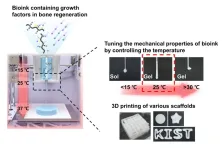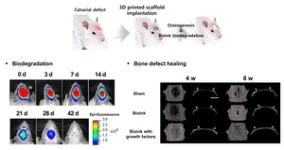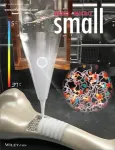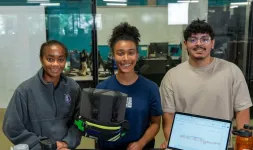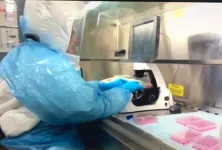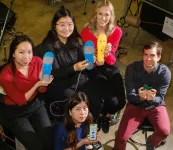(Press-News.org) The development of biomaterials for artificial organs and tissues is active due to an increase in accidental injuries and chronic diseases, along with the entry into a super-aged society. 3D bioprinting technology, which uses cells and biomaterials to create three-dimensional artificial tissue structures, has recently gained popularity. However, commonly used hydrogel-based bioinks can cause cytotoxicity due to the chemical crosslinking agent and ultraviolet light that connect the molecular structure of photocuring 3D-printed bioink.
Dr. Song Soo-chang's research team at the Center for Biomaterials, Korea Institute of Science and Technology (KIST, President Yoon Seok-jin), revealed the first development of poly(organophosphazene) hydrogel-based temperature-sensitive bioink that stably maintained its physical structure only by temperature control without photocuring, induced tissue regeneration, and then biodegraded in the body after a certain period of time.
Current hydrogel-based bioinks must go through a photocuring process to enhance the mechanical properties of the 3D scaffold after printing, with a high risk of adverse effects in the human body. In addition, there have been possibility of side effects by transplanting externally cultured cells within bioink to increase the tissue regeneration effect. Accordingly, the research team developed a new bioink material using a temperature-sensitive poly(organophosphazene) hydrogel, which existed in a liquid form at low temperatures and changed to a hard gel at body temperature. This enabled the regeneration of tissues only by temperature control without chemical crosslinking agents or UV irradiation and the manufacture of a three-dimensional scaffold with a physically stable structure, minimizing the possibility of immune adverse effects in the human body.
The developed bioink also had a molecular structure that could interact with growth factors, which were proteins that help in tissue regeneration to preserve growth factors that regulated cell growth, differentiation, and immune responses for a long period of time. The research team was able to maximize the effect of tissue regeneration by creating an environment in which cell differentiation could be autonomously regulated within the 3D scaffold printed with bioink.
The research team fabricated the 3D scaffold by printing it with a 3D bioprinter using bioink containing transforming growth factor beta 1 (TGF-β1) and bone morphogenetic protein-2 (BMP-2), which were required for cell infiltration and bone regeneration, and conducted an experiment by implanting it into a damaged bone in a rat. As a result, cells from the surrounding tissue were migrated into the scaffold, and the defected bone was regenerated to a normal tissue level, and the implanted 3D scaffold slowly biodegraded in the body over 42 days.
Dr. Song Soo-Chang of KIST said, "The research team has transferred technology for the thermo-sensitive polyphosphazene hydrogel to NexGel Biotech Co., Ltd. in June 2022, and the development of products such as bone graft materials and cosmetic fillers is underway." "As the bioink developed this time has different physical properties, follow-up research to apply it to the regeneration of other tissues besides bone tissue is being conducted, and we expect to finally be able to commercialize bioink tailored to each tissue and organ," he said.
###
KIST was established in 1966 as the first government-funded research institute in Korea. KIST now strives to solve national and social challenges and secure growth engines through leading and innovative research. For more information, please visit KIST’s website at https://eng.kist.re.kr/
This research was conducted through the KIST Major Projects supported by the Ministry of Science and ICT (Minister Lee Jong-ho), and the research results were published as the inside back cover in the latest issue of Small (IF: 15.153, top 7.101% in the JCR field), an international academic journal in the field of materials.
END
Safe bioink for artificial organ printing
Development of 3D bioprinting ink that induces tissue regeneration without photocuring, Expected applications including patient-specific regenerative treatment technologies, such as artificial organs
2023-04-14
ELSE PRESS RELEASES FROM THIS DATE:
Researchers turn to the power of native aquatic plants to clean coastal waters
2023-04-14
To find a fast, efficient way to clear harmful chemicals along the Gulf of Mexico coastline, researchers are turning to something already familiar with the task – several species of the aquatic grasses and rice that feel very much at home in murky coastal waters.
The research team led by University of Houston’s Venkatesh Balan, associate professor of biotechnology in the Cullen College of Engineering’s Division of Technology, studies the abilities of these water-loving flora to uptake concentrations ...
Rice U. engineering students’ brace puts patients first
2023-04-13
HOUSTON – (April 13, 2023) – Body image can have a significant impact on a person’s life, especially in their youth.
For those suffering from rib flaring associated with congenital deformations of the chest wall that cause it to jut out or cave in, a team of Rice University engineering students has come up with a potential solution.
Pectus carinatum and pectus excavatum are conditions in which a person is born with their breastbone protruding outward or sunken inward, respectively. There ...
PPPL hosts workshop on fusion energy and nonproliferation
2023-04-13
Public and private organizations around the world are developing fusion energy devices that could serve as models for fusion power plants. Scientists are striving to duplicate the fusion power that drives the sun and stars as a source of carbon-free energy to generate electricity without contributing to climate change.
While fusion plants could help meet global energy demands without emitting greenhouse gases and producing long-lived radioactive waste, they could also have risks — many of which were discussed at a two-day workshop hosted by the U.S. Department of Energy’s (DOE) Princeton Plasma Physics Laboratory ...
Nurses trained via virtual reality performed better than those trained by inpatient clinical training
2023-04-13
In search of novel tactics to accommodate a larger student body and fulfill workforce demands, nursing schools are developing new approaches to optimize learning, engage learners, and provide methods to ensure competency in future nursing graduates.
A recent study by Bethany Cieslowski, associate professor of Nursing, and colleagues found that immersive virtual reality (VR) training has been shown to be as effective as inpatient training for students learning to provide care for acute care pediatric ...
Hallmarks to improving pancreatic cancer therapy identified by UC Irvine researchers
2023-04-13
Irvine, Calif., April 13, 2023 — Scientists from the University of California, Irvine, the University of Michigan and the University of Texas MD Anderson Cancer Center have made a significant contribution to the field of pancreatic cancer research. Their new study presents several crucial themes in the biology of pancreatic cancer that can serve as hallmarks for pancreatic cancer therapy. These themes include genomic alterations, metabolism, the tumor microenvironment, immunotherapy and innovative clinical trial design. The study appears in the journal Cell.
(Link to study: https://www.cell.com/cell/fulltext/S0092-8674(23)00142-3)
Pancreatic ...
Four major Illinois research institutions form a collaboration to improve urban forest drought resilience
2023-04-13
Scientists at four leading Illinois research institutions, three in the Chicago region, are forming a new collaboration to study the effects of drought on urban trees and develop more effective drought response strategies nationwide through a grant from the National Oceanic and Atmospheric Administration (NOAA).
The project is being led by researchers at The Morton Arboretum in conjunction with the U.S. Department of Energy’s Argonne National Laboratory, the University of Chicago and the Illinois State Water Survey at the Prairie Research ...
Good news! Only a modest reduction in added sugars consumption is needed to achieve the Healthy People 2030 target
2023-04-13
Ann Arbor, April 13, 2023 – Reducing caloric intake from added sugars is a Leading Health Indicator in Healthy People 2030, a national public health initiative led by the US Department of Health and Human Services that sets data-driven national objectives to improve health and wellbeing over the next decade. Although many Americans consume too much sugar, investigators found that only a modest reduction in added sugars intake is needed to reach a population mean of 11.5% of calories from added sugars by 2030. Prioritizing reducing added sugars intake among people not meeting recommendations could help those most at risk for chronic disease related to added sugars consumption. They report ...
T-cell vaccine for COVID-19 may last longer than current vaccines
2023-04-13
UNIVERSITY PARK, Pa. — The current COVID-19 vaccines are designed to trigger an antibody response to the SARS-CoV-2 spike protein, which is vulnerable to mutations that could make the vaccine less effective over time. Focusing on the T-cell instead, Penn State researchers partnered with Evaxion Biotech on a study that was the first to demonstrate the effectiveness of an artificial intelligence-generated vaccine in a live viral challenge model. Such a vaccine may provide long-lasting immunity against future emerging variants and could be used as a model for other seasonal viral diseases ...
Rice U. students engineer socks for on-the-go neuropathy treatment
2023-04-13
HOUSTON – (April 13, 2023) – Need a little spring — or buzz — in your step? A wearable electrical-stimulation and vibration-therapy system designed by Rice University engineering students might be just what the doctor ordered for people experiencing foot pain and balance loss due to diabetic neuropathy.
Rice engineering students in the StimuSock team — Abby Dowse, Yannie Guo, Andrei Mitrofan, Sarah Park and Kelly Xu — designed a sock with a smart insole that can deliver both transcutaneous electrical nerve stimulation (TENS) and vibration therapy that block pain signals to the brain and ...
UC Davis study finds tweets can amplify, disrupt, unite and divide
2023-04-13
Social media connects people and amplifies different aspects of humanity in good and bad ways. But the effects of social media appear neither universally good nor bad, but rather present an oscillating, dynamic system that can be divisive but also uniting, a new University of California, Davis, study suggests.
Department of Communication researchers said their findings both in an observational study and simulation speak to the ongoing debate about social media’s contributions to political polarization, misinformation and echo chambers. To conduct their research, ...
LAST 30 PRESS RELEASES:
Sleeping in on weekends may help boost teens’ mental health
Study: Teens use cellphones for an hour a day at school
After more than two years of war, Palestinian children are hungry, denied education and “like the living dead”
The untold story of life with Prader-Willi syndrome - according to the siblings who live it
How the parasite that ‘gave up sex’ found more hosts – and why its victory won’t last
When is it time to jump? The boiling frog problem of AI use in physics education
Twitter data reveals partisan divide in understanding why pollen season's getting worse
AI is quick but risky for updating old software
Revolutionizing biosecurity: new multi-omics framework to transform invasive species management
From ancient herb to modern medicine: new review unveils the multi-targeted healing potential of Borago officinalis
Building a global scientific community: Biological Diversity Journal announces dual recruitment of Editorial Board and Youth Editorial Board members
Microbes that break down antibiotics help protect ecosystems under drug pollution
Smart biochar that remembers pollutants offers a new way to clean water and recycle biomass
Rice genes matter more than domestication in shaping plant microbiomes
Ticking time bomb: Some farmers report as many as 70 tick encounters over a 6-month period
Turning garden and crop waste into plastics
Scientists discover ‘platypus galaxies’ in the early universe
Seeing thyroid cancer in a new light: when AI meets label-free imaging in the operating room
Neutrophil-to-lymphocyte ratio may aid risk stratification in depressive disorder
2026 Seismological Society of America Annual Meeting
AI-powered ECG analysis offers promising path for early detection of chronic obstructive pulmonary disease, says Mount Sinai researchers
GIMM uncovers flaws in lab-grown heart cells and paves the way for improved treatments
Cracking the evolutionary code of sleep
Medications could help the aging brain cope with surgery, memory impairment
Back pain linked to worse sleep years later in men over 65, according to study
CDC urges ‘shared decision-making’ on some childhood vaccines; many unclear about what that means
New research finds that an ‘equal treatment’ approach to economic opportunity advertising can backfire
Researchers create shape-shifting, self-navigating microparticles
Science army mobilizes to map US soil microbiome
Researchers develop new tools to turn grain crops into biosensors
[Press-News.org] Safe bioink for artificial organ printingDevelopment of 3D bioprinting ink that induces tissue regeneration without photocuring, Expected applications including patient-specific regenerative treatment technologies, such as artificial organs
